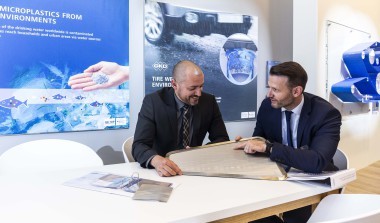Study on the level of knowledge about micro an macro plastics
Particularly in the summer holidays, millions of holiday-makers flock to the most beautiful beaches. Unfortunately, these are the places, where despite such idyll, litter pollution by plastic waste is very obvious. On closer inspection, microplastics can be discovered between sand and shells. But where do the tiny plastic particles come from? Which volumes are emitted in Germany each year? Among others, these questions were in the focus of the “Konsortialstudie Mikroplastik”. On behalf of partners from the plastics industry, the water sector, waste industry and research, Fraunhofer UMSICHT gathered the state of knowledge with regard to micro- and macroplastics within the past two years. An abridged version including conclusions and recommendations is freely available from now.
Categorization of microplastics
Initially, within the context of this study, a new categorization of microplastics was carried out: primary microplastics of Type A are industrially manufactured plastic particles, whose loss is deliberately accepted or caused by negligence. These include e.g. microbeads in cosmetics or plastic pellets. Primary microplastics of Type B however occur during the use phase due to abrasion or weathering. This is the case, for example, with car tyres, shoe soles, textiles or paints. If plastic waste, mainly packaging, plastic bags or bottles – so-called macroplastics – gets into the environment and is fragmented there, it is allocated to secondary microplastics. The new categorization is important, in particular for the assignment of responsibilities. Depending on the source, these are either more on the manufacturer’s or on the consumer’s side.
In Germany, microplastics account for 74 % of plastic emissions
The authors of the Konsortialstudie identified altogether 51 sources of microplastics and calculated the emissions. Tyre wear particles, particle release during waste disposal, abrasion of bitumen in asphalt, pellet losses, wind-blown dispersal from sports and play grounds are at the top. The release of microplastics from cosmetics, for example, is ranked 17th. In this context, it is to be noted that reducing emissions from any kind of source is important. Further factors, such as biodegradability or plastic additives also play a major role in the impact on the environment and should thus be considered in the prioritization of the sources. Assuming that there are still other sources, Germany’s total volume amounts to some 4 kg per capita[1], which is annually released into the environment. Emissions of macroplastics, in turn, amount to only 1.4 kg per capita and year[2]. Thus, the plastic waste we find in service areas, in parks and on the beach is only the visible but by far smaller part of plastics to be found in the environment.
At the expense of sewage slug
Urban water management plays an important role in the emission of plastics into the environment, both as an entry path and as a means of retention. About 78 % of the waste water are cleaned within the urban water management in sewage treatment plants. The remaining 22 %, mainly precipitation water, are only partially purified, thus macro- and microplastics are flushed into the ecosystems by precipitations. Depending on the technical equipment, sewage treatment plants retain more than 95 % of the incoming microplastics. “The high retention rate of sewage treatment plants, however, is at the expense of the sludge, in which the fragmented plastics accumulate. Here, it must be analyzed on a case-by-case basis, if a complete combustion of the sludge deriving from utilization for agricultural and landscaping purposes is preferable to avoid the further proliferation of microplastics into the environment, and thus a shift of problems,” says Ralf Bertling, Department of Photonics and
Environment at the Fraunhofer UMSICHT, who dedicated his work within the framework of the study to urban water management. The co-author continues: “Moreover, urban water management means ‘more than water sewage plants’. Much more attention should be paid to the type of drainage system – separation or mixing system – and also to the precipitation drainage inside and outside of built-up areas. Rain and other weather phenomena flush tyre wear or plastic waste, for example, not only into the sewer system, but almost everywhere.” Mainly out-of town areas, not every liter of rain is treated, but often flows, directly or indirectly, into the next water body without being purified, in particular in case of heavy rain.
Adding value to plastics
The results of the study were presented on July 21, 2018 in Berlin and afterwards discussed by consortium partners, experts and audience. To the authors, it was important to provide solutions, to draw up conclusions and to give recommendations. “Adding value to plastics” was one of the most frequently emphasized aspects of the event.
“We can assume that microplastics has already entered into all areas of the environment. This is the simple result of the fact that we use plastics everywhere and the emissions are spread by wind and water. So it is no wonder that we find microplastics in the air, in the drinking water or in foodstuffs,” says Leandra Hamann, Department of Sustainability and Resource Management at Fraunhofer UMSICHT and also co-author of the study. Even though a concrete risk potential has not shown up so far, all parties involved agree that plastics in the environment have to be reduced.
Besides an expansion of the circular circular economy, prohibitions of certain products, the development of new filter systems and the adaptation of the urban water management, everybody can do something on his own: “If you are out and about anyway, just pick up the litter lying about and throw it into the next dustbin. This works particularly well when being on holidays, as we usually have more time and the view to the environment is more intensive. However, for me, this already goes without saying even in everyday life.” Apart from the disposal of waste, Hamann is in particular concerned about drawing attention to the problem and to encourage others to take action, too.
Microplastics and Fraunhofer UMSICHT
The working group „Microplastics“ of Fraunhofer UMSICHT has already been dealing with microplastics and plastics in the environment since 2014. Currently, projects are underway on the evaluation of microplastics by means of life-cycle-analysis, the creation of a model regarding volumes and the proliferation of tyre abrasion, the development of filters for washing machines to retain microplastics as well as on the impact of plastics on agricultural land. Another report on microplastics in cosmetics, detergents and cleaners drawn up in cooperation with the headquarters of the NABU e.V. was published in July 2018.







